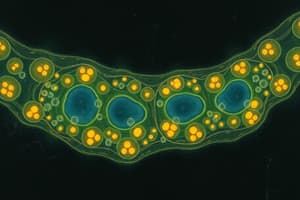Podcast
Questions and Answers
What is the primary difference in electrical properties between the plasma and cytoplasm of a cell?
What is the primary difference in electrical properties between the plasma and cytoplasm of a cell?
- Plasma has more potassium ions, while cytoplasm has more sodium ions
- Plasma and cytoplasm have identical ion concentrations
- Plasma has more sodium ions, while cytoplasm has more potassium ions (correct)
- There is no difference in electrical properties between plasma and cytoplasm
What are the two common characteristics of the plasma and cytoplasm in terms of particle concentrations?
What are the two common characteristics of the plasma and cytoplasm in terms of particle concentrations?
- Electroneutrality and equal osmotic pressures. (correct)
- Different osmotic pressures and electroneutrality.
- High permeability for ions and water.
- Equal ion concentrations and different osmotic pressures.
The cell membrane is least permeable to:
The cell membrane is least permeable to:
- Water
- Oxygen
- Ions (correct)
- Gasses
How do carrier proteins facilitate transport across the cell membrane?
How do carrier proteins facilitate transport across the cell membrane?
Aquaporins primarily facilitate the transport of:
Aquaporins primarily facilitate the transport of:
Which statement best describes Na-K leak channels?
Which statement best describes Na-K leak channels?
The selectivity of protein channels in a cell membrane is primarily determined by:
The selectivity of protein channels in a cell membrane is primarily determined by:
Which molecules pass through the lipid bilayer of the cell membrane most easily?
Which molecules pass through the lipid bilayer of the cell membrane most easily?
Which of the following best describes the role of transport proteins in the cell membrane?
Which of the following best describes the role of transport proteins in the cell membrane?
Aquaporins are specialized for transporting:
Aquaporins are specialized for transporting:
Which of the following statements is true about protein channels in cell membranes?
Which of the following statements is true about protein channels in cell membranes?
Na-K leak channels are characterized by:
Na-K leak channels are characterized by:
Which statement correctly describes the structure of a typical cell membrane?
Which statement correctly describes the structure of a typical cell membrane?
The primary function of cholesterol in the cell membrane is to:
The primary function of cholesterol in the cell membrane is to:
What is the significance of the cell membrane's 'fluid mosaic model'?
What is the significance of the cell membrane's 'fluid mosaic model'?
What is the primary function of voltage-dependent protein channels in cells?
What is the primary function of voltage-dependent protein channels in cells?
Facilitated diffusion differs from regular diffusion in that it:
Facilitated diffusion differs from regular diffusion in that it:
Osmosis in cells refers to:
Osmosis in cells refers to:
The Na-K pump is an example of:
The Na-K pump is an example of:
Ligand-gated channels in the cell membrane open in response to:
Ligand-gated channels in the cell membrane open in response to:
Facilitated diffusion is characterized by:
Facilitated diffusion is characterized by:
Osmosis can be best described as:
Osmosis can be best described as:
In active transport, how are substances moved across a cell membrane?
In active transport, how are substances moved across a cell membrane?
Which factor primarily determines the direction of net diffusion of molecules in a solution?
Which factor primarily determines the direction of net diffusion of molecules in a solution?
The osmotic pressure of a solution is directly proportional to:
The osmotic pressure of a solution is directly proportional to:
In the context of membrane transport, 'active transport' is best described as:
In the context of membrane transport, 'active transport' is best described as:
What is the role of the Na-K pump in cellular function?
What is the role of the Na-K pump in cellular function?
Which statement accurately describes osmotic swelling and shrinkage of cells?
Which statement accurately describes osmotic swelling and shrinkage of cells?
The Nernst equation is used to calculate:
The Nernst equation is used to calculate:
Which process best describes the movement of glucose into a cell?
Which process best describes the movement of glucose into a cell?
What is the primary role of the Na-K pump in maintaining cell volume?
What is the primary role of the Na-K pump in maintaining cell volume?
In secondary active transport, the energy to transport molecules is derived from:
In secondary active transport, the energy to transport molecules is derived from:
Which statement correctly describes osmotic pressures in solutions?
Which statement correctly describes osmotic pressures in solutions?
How does the concentration of ions inside and outside a cell primarily affect the membrane potential?
How does the concentration of ions inside and outside a cell primarily affect the membrane potential?
The Goldman equation is used to calculate:
The Goldman equation is used to calculate:
What is a primary function of secondary active transport in cells?
What is a primary function of secondary active transport in cells?
Which of the following best describes the role of ion channels in the cell membrane?
Which of the following best describes the role of ion channels in the cell membrane?
In the context of cell membrane transport, what does 'selectivity' refer to?
In the context of cell membrane transport, what does 'selectivity' refer to?
Which statement best describes the effect of membrane potential on the movement of ions across the cell membrane?
Which statement best describes the effect of membrane potential on the movement of ions across the cell membrane?
The process of active transport in cells is characterized by:
The process of active transport in cells is characterized by:
Osmotic pressure in cells is most directly affected by:
Osmotic pressure in cells is most directly affected by:
Which of the following is true about facilitated diffusion?
Which of the following is true about facilitated diffusion?
In secondary active transport, what is the relationship between the transport of sodium and the co-transported substance?
In secondary active transport, what is the relationship between the transport of sodium and the co-transported substance?
Which statement is true about the Na-K pump's role in nerve signal conduction?
Which statement is true about the Na-K pump's role in nerve signal conduction?
In the context of membrane transport, what does 'saturation kinetics' refer to?
In the context of membrane transport, what does 'saturation kinetics' refer to?
Which factor primarily influences the movement of ions due to the electric field across a cell membrane?
Which factor primarily influences the movement of ions due to the electric field across a cell membrane?
The concept of 'electrochemical equilibrium' in cells refers to:
The concept of 'electrochemical equilibrium' in cells refers to:
What does the 'reflection coefficient' in membrane transport indicate?
What does the 'reflection coefficient' in membrane transport indicate?
What effect does the Na-K pump have on the concentration of ions inside the cell?
What effect does the Na-K pump have on the concentration of ions inside the cell?
Secondary active transport is distinguished by:
Secondary active transport is distinguished by:
In facilitated diffusion, what role do transport proteins play?
In facilitated diffusion, what role do transport proteins play?
The concept of 'osmotic pressure' is best explained as:
The concept of 'osmotic pressure' is best explained as:
What is the primary factor determining the direction of water movement in osmosis?
What is the primary factor determining the direction of water movement in osmosis?
In terms of membrane transport, what is the significance of the 'reflection coefficient'?
In terms of membrane transport, what is the significance of the 'reflection coefficient'?
Which ions primarily contribute to the resting membrane potential in neurons?
Which ions primarily contribute to the resting membrane potential in neurons?
What is the primary purpose of the Na-K pump in cellular activity?
What is the primary purpose of the Na-K pump in cellular activity?
Which process describes the movement of water from an area of low solute concentration to an area of high solute concentration?
Which process describes the movement of water from an area of low solute concentration to an area of high solute concentration?
The term 'electrogenic transport' refers to:
The term 'electrogenic transport' refers to:




